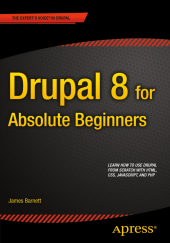 Neuerscheinungen 2016Stand: 2020-02-01 |
Schnellsuche
ISBN/Stichwort/Autor
|
Herderstraße 10
10625 Berlin
Tel.: 030 315 714 16
Fax 030 315 714 14
info@buchspektrum.de |

James Barnett
Drupal 8 for Absolute Beginners
1st ed. 2015. 2016. xxii, 337 S. 188 SW-Abb. 254 mm
Verlag/Jahr: SPRINGER, BERLIN; APRESS 2016
ISBN: 1-430-26466-7 (1430264667)
Neue ISBN: 978-1-430-26466-8 (9781430264668)
Preis und Lieferzeit: Bitte klicken
Drupal 8 for Absolute Beginners is your definitive guide to starting from scratch with Drupal even if you have little web knowledge. This book teaches you the basics of HTML, CSS, JavaScript, and PHP in relation to Drupal, so that you can begin to use this popular CMS with all of its features.
You will first learn how to set up and customize a basic blog using Drupal, one of the most powerful and popular content management systems available today. From there you will learn the basics of HTML, CSS, JavaScript and PHP, and apply this knowledge to create your own custom Drupal module. You will learn how to build, style, and add functionality to your own Drupal module from scratch. You will then use Drush to apply a theme to Drupal, customizing everything to your liking, before publishing your work to the world. The book also covers some more advanced topics that beginners often ask about, such as getting set up with Git and using source control, using MySQL to interact with a database, and a guide to getting up and running with Linux.
Rarely has all the knowledge required to start with Drupal been collated in one place as it is in Drupal 8 for Absolute Beginners . You need no prior knowledge of the web, only a desire to learn. The book is fully supported by video material on the author´s website. Start your Drupal journey with this book today!
1. Setting Up Your Development Environment and Installing Drupal
2. Site Building: Building Drupal Sites Without Programming
3. Getting Started with HTML
4. Creating a Basic Drupal Module with HTML Output
5. A CSS Primer for Drupal
6. Adding CSS to Your Drupal Module
7. A JavaScript Primer for Drupal
8. Adding JavaScript to Your Drupal Module
9. A PHP Primer for Drupal
10. Adding PHP-Generated Output to Your Drupal Module
11. Creating a Drupal Block Programmatically and Basic MySQL Usage
12. Theming Your Site Part 1: Theme Functions and a Twig Primer
13. Theming Your Site Part 2: Creating a Custom Theme and Overriding Functions
14. Commonly Needed Custom Code, node_save, Forms
15. Using Git to Manage Your Source Code
16. An Advanced MySQL Primer
17. A Linux Primer for Drupal
18. Publishing Your Site to a Production Linux Box
19. Appendix: Other Ways to Install Drupal
James Barnett is an application architect and adjunct Professor in the Tech. Ops. & Information Management Division at Babson College. Besides teaching, his responsibilities include designing, coding, and releasing tools and websites for the college, working with Babson s leaders to keep Babson at the forefront of the technology space. In the last two years at Babson, James team has released the advanced discussion boards, the new Faculty Portal and Student Portal websites, as well as other important initiatives for Babson. James has brought Drupal Content Management System expertise to Babson a technology which accelerates development of cutting edge web platforms for community sites, web portals, and everything else the web can provide.James holds a Masters in Economics and Finance from Brandeis University, and as well a BA from Brandeis University. Past work experiences in the technology space include positions at: EMC, Fidelity, IDG, work as a consultant managing all the software technology needs of a startup out of Needham for over 3 years. As a technology consultant for many companies, he found success providing programming, database and information management, and system administration expertise.James areas of expertise include: PHP, MYSQL, Oracle, SQL, PL/SQL, Unix/Linux, shell scripting, apache, JAVA, PERL, XSLT, JSON, XML, Ruby, Ruby on Rails, HTML, CSS, JavaScript, AJAX, network operations skills, information management, load balancers, and front- and back-end web work.


